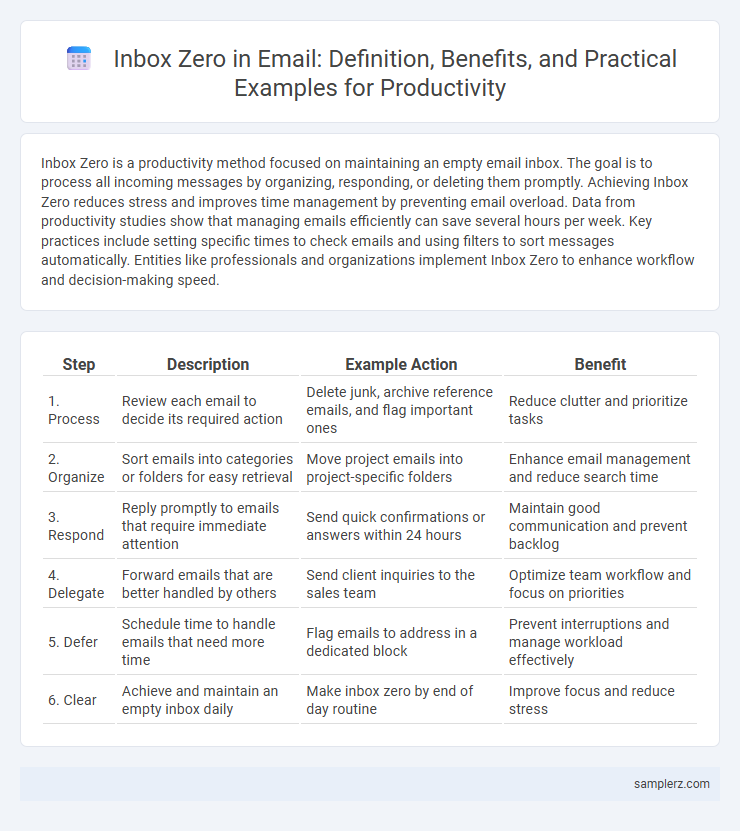Inbox Zero is a productivity method focused on maintaining an empty email inbox. The goal is to process all incoming messages by organizing, responding, or deleting them promptly. Achieving Inbox Zero reduces stress and improves time management by preventing email overload. Data from productivity studies show that managing emails efficiently can save several hours per week. Key practices include setting specific times to check emails and using filters to sort messages automatically. Entities like professionals and organizations implement Inbox Zero to enhance workflow and decision-making speed.
Table of Comparison
| Step | Description | Example Action | Benefit |
|---|---|---|---|
| 1. Process | Review each email to decide its required action | Delete junk, archive reference emails, and flag important ones | Reduce clutter and prioritize tasks |
| 2. Organize | Sort emails into categories or folders for easy retrieval | Move project emails into project-specific folders | Enhance email management and reduce search time |
| 3. Respond | Reply promptly to emails that require immediate attention | Send quick confirmations or answers within 24 hours | Maintain good communication and prevent backlog |
| 4. Delegate | Forward emails that are better handled by others | Send client inquiries to the sales team | Optimize team workflow and focus on priorities |
| 5. Defer | Schedule time to handle emails that need more time | Flag emails to address in a dedicated block | Prevent interruptions and manage workload effectively |
| 6. Clear | Achieve and maintain an empty inbox daily | Make inbox zero by end of day routine | Improve focus and reduce stress |
What is Inbox-Zero and Why It Matters
Inbox-Zero is a productivity strategy aimed at keeping the email inbox empty or nearly empty by processing and organizing messages efficiently. Maintaining Inbox-Zero reduces stress, minimizes distractions, and improves focus by ensuring important tasks and communications are promptly addressed. This approach enhances time management and supports overall workflow optimization in professional and personal settings.
Key Benefits of Achieving Inbox-Zero
Achieving inbox-zero streamlines email management by reducing cognitive overload and minimizing distractions, allowing for enhanced focus on priority tasks. It facilitates faster response times and improved organization, leading to higher efficiency and better time management throughout the workday. Maintaining a zeroed inbox supports mental clarity and decreases stress, which boosts overall productivity and workplace satisfaction.
Step-by-Step Process to Reach Inbox-Zero
Achieving inbox zero involves a structured process starting with categorizing all unread emails into actionable, reference, or deletion groups. Next, set specific time blocks daily to respond to or archive messages, ensuring continuous maintenance. Utilize tools like filters and labels in email clients to automate sorting, preventing future clutter and enhancing overall productivity.
Real-Life Example: Achieving Inbox-Zero in Gmail
Achieving inbox-zero in Gmail can be exemplified by using filters to automatically sort incoming emails into labels such as Promotions, Social, and Updates, reducing clutter in the primary inbox. Implementing the "Reply Later" label helps prioritize urgent messages while deferring less important ones, enhancing focus on critical tasks. Regularly scheduling 15-minute daily review sessions to archive, delete, or respond to emails maintains a clean inbox and improves overall productivity.
Automating Email Organization for Inbox-Zero
Automating email organization for inbox-zero leverages tools like filters, labels, and rules to automatically sort incoming messages into predefined categories, reducing manual sorting time. Advanced email clients integrate AI-driven prioritization to highlight important emails while archiving or deleting low-priority messages, ensuring an uncluttered inbox. Utilizing automation enhances productivity by maintaining zero unread emails, streamlining workflow, and minimizing distractions.
Essential Tools for Maintaining Inbox-Zero
Essential tools for maintaining inbox-zero include advanced email clients like Microsoft Outlook and Gmail, which offer robust filtering and sorting capabilities. Task management apps such as Todoist and Trello integrate seamlessly to prioritize and track actionable emails. Email automation tools like SaneBox and Unroll.Me help declutter the inbox by filtering newsletters and non-urgent messages, ensuring focus on high-priority communications.
Common Challenges in Staying at Inbox-Zero
Maintaining inbox zero frequently encounters obstacles such as overwhelming email volume, constant interruptions, and difficulty prioritizing messages. Many users struggle with managing time effectively to process emails promptly, leading to backlog accumulation. Filtering irrelevant content and resisting the urge to multitask during email review are crucial yet challenging aspects of sustaining inbox zero.
Inbox-Zero Success Stories: Productivity Boosts
Achieving Inbox Zero has significantly enhanced productivity for professionals by reducing email overload and minimizing task-switching. Companies like Basecamp have reported improved focus and faster decision-making after adopting Inbox Zero practices. Users consistently experience decreased stress and increased time for priority tasks, demonstrating the effectiveness of this productivity strategy.
Tips to Sustain Inbox-Zero Long-Term
Implementing consistent email habits such as scheduling specific times for checking and processing messages helps maintain inbox-zero long-term. Using filters and labels automatically organizes incoming emails, reducing clutter and prioritizing important correspondence. Regularly unsubscribing from unnecessary newsletters and promptly archiving or deleting emails prevents backlog and supports sustained productivity.
Frequently Asked Questions About Inbox-Zero
Inbox-zero is a popular productivity method aimed at keeping the email inbox empty or nearly empty at all times to reduce stress and improve focus. Frequently asked questions about inbox-zero include how to effectively categorize emails, the best frequency for checking emails, and tools that support rapid email triage and archiving. Implementing techniques such as prioritizing urgent messages, using filters for automatic organization, and scheduling dedicated email review times are essential strategies.

example of inbox-zero in email Infographic
 samplerz.com
samplerz.com